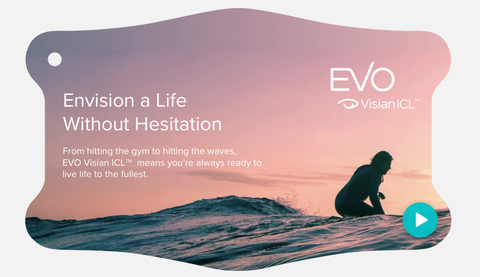EVO Lenses Provide Visual Freedom from Contact Lenses and Glasses
Over One Million EVO Lenses Have Already Been Implanted Worldwide
Information for Patients and Doctor Finder at DiscoverEVO.com
STAAR Surgical Company (NASDAQ: STAA), a leading developer, manufacturer and marketer of implantable lenses and companion delivery systems for the eye, today announced that the U.S. Food and Drug Administration (FDA) has granted approval of the EVO/EVO+ Visian® Implantable Collamer® Lens (“EVO”) for the correction of myopia and myopia with astigmatism. Myopia, which is also known as nearsightedness or the need for distance vision correction, is the most common vision disorder globally and its prevalence is rapidly growing.1 An estimated 100 million U.S. adults ages 21 to 45 who have myopia are potential candidates for EVO, a biocompatible implantable lens that corrects distance vision.2
This press release features multimedia. View the full release here: https://www.businesswire.com/news/home/20220328005207/en/

EVO Visian ICL, Envision A Life Without Hesitation. (Graphic: Business Wire)
See Video, EVO Visian ICL, Envision A Life Without Hesitation: https://vimeo.com/646690200/bd1457636b
See Video, EVO Visian ICL Information and Animated Procedure: https://vimeo.com/646689696/1181db7c57
"Following FDA approval, prospective patients in the U.S. and their doctors may now consider EVO for achieving Visual Freedom from the limitations, ongoing maintenance and inconvenience associated with glasses and contact lenses,” said Caren Mason, President and CEO of STAAR Surgical. “Over one million EVO lenses have already been implanted by doctors outside the U.S. and 99.4% of EVO patients in a survey have stated they would have the procedure again.3 The EVO lens is additive, provides excellent quality of vision day and night, does not cause dry eye syndrome and is removable by a doctor, if ever so desired.4,5,6 Sales of EVO lenses outside the U.S. increased 51% in 2021 and have more than doubled since 2018, which speaks to the increasing choice by patients and our surgeon partners for EVO as the premium and primary solution for refractive vision correction. Surgeons will be trained and certified for EVO, and begin implanting EVO in the coming days and weeks in select cities. Commercialization of EVO in the U.S. will begin immediately and be supported by a nationwide advertising, marketing and public relations campaign. We wish to express our great appreciation for the outstanding work of our esteemed principal investigator surgeons and their staffs who enrolled patients, implanted and conducted follow-up per the clinical trial protocol during the most challenging of times.”
STAAR’s Implantable Collamer lenses have been improving vision in patients for more than 20 years globally. EVOs are implanted within the posterior chamber of the eye directly behind the iris and in front of the natural crystalline lens. Earlier versions of the Visian ICL lens in the U.S. required a preoperative peripheral iridotomy that is now eliminated with EVO, thereby optimizing patient comfort and time efficiency for both the surgeon and the patient. EVO offers a lens-based alternative for the correction/reduction of refractive error in people who currently use glasses and/or contact lenses for distance vision correction. A U.S. multicenter, prospective clinical investigation confirmed the safety of the EVO family of myopia lenses. There are now more than 100 clinical papers available discussing the safety and efficacy of the Visian ICL family of lenses globally.
Scott D. Barnes, MD, Chief Medical Officer of STAAR Surgical, stated, “We are thrilled to make EVO available to U.S. surgeons and patients seeking a proven and premium option to glasses, contact lenses or laser vision correction. Today’s announcement is especially important because the prevalence of myopia is increasing quickly, and COVID precautions have presented additional challenges to people wearing glasses and/or contact lenses. EVO adds an important tool for the ophthalmic surgeon seeking to help improve a patient’s quality of life. Different from LASIK, the EVO lens is added to the patient’s eye through a relatively quick surgical procedure where there is no removal of corneal tissue. Moreover, the EVO lens is removable by a doctor if ever desired. Results from our recent U.S. clinical trial are consistent with the more than one million EVO lenses that have already been implanted around the world.”
EVO Visian® ICL (Implantable Collamer® Lens) is indicated for use in phakic eye treatment in patients 21–45 years of age:
- for the correction/reduction of myopia in patients with spherical equivalent ranging from -3.0 D to -20.0 D at the spectacle plane;
- for the correction/reduction of myopic astigmatism in patients with spherical equivalent ranging from -3.0 D to -20.0 D with cylinder of 1.0 D to 4.0 D at the spectacle plane;
- with an anterior chamber depth (ACD) of 3.00 mm or greater, when measured from the corneal endothelium to the anterior surface of the crystalline lens;
- and a stable refractive history (within 0.5 D for 1 year prior to implantation).
1 Holden BA, Fricke TR, Wilson DA, et al. Global Prevalence of Myopia and High Myopia and Temporal Trends from 2000 through 2050. Ophthalmology. 2016.
2 Market Scope, Refractive Surgery Report, 2019 and Company estimates. Company estimates that more than one in three of the 330 million U.S. population is between 21-45 years old with myopia greater than -3.0 D and has the willingness to undergo an EVO procedure, the financial ability to pay for EVO and is relatively close in terms of distance to a certified surgeon.
3 Packer, The Implantable Collamer Lens with a central port: review of the literature, Clinical Ophthalmology, 2018.
4 EVO/EVO+ ICL DFU and PIB.
5 Martinez-Plazs E, Lopez-Miguel A, Lopez-De La Rosa A, et al. Effect of the EVO+ Visian Phakic Implantable Collamer Lens on Visual Performance and Quality of Vision and Life, Am J Ophthalmol 2021;226: 117–125.
6 Naves, J. Carracedo, G. Cacho-Babillo, I. Diadenosine Nucleotid Measurements as Dry-Eye Score in Patients After LASIK and ICL Surgery. Presented at American Society of Cataract and Refractive Surgery (ASCRS) 2012.
About STAAR Surgical
STAAR, which has been dedicated solely to ophthalmic surgery for over 30 years, designs, develops, manufactures and markets implantable lenses for the eye with companion delivery systems. These lenses are intended to provide visual freedom for patients, lessening or eliminating the reliance on glasses or contact lenses. All of these lenses are foldable, which permits the surgeon to insert them through a small incision. STAAR’s lens used in refractive surgery is called an Implantable Collamer® Lens or “ICL,” which includes the EVO Visian ICL™ product line. More than 1,000,000 Visian® ICLs have been implanted to date and STAAR markets these lenses in over 75 countries. To learn more about the ICL go to: www.discovericl.com. Headquartered in Lake Forest, CA, the company operates manufacturing and packaging facilities in Aliso Viejo, CA, Monrovia, CA and Nidau, Switzerland. For more information, please visit the Company’s website at www.staar.com.
Safe Harbor
All statements that are not statements of historical fact are forward-looking statements, including statements about any of the following: any projections (including sales), plans, strategies, and objectives of management for the EVO Visian ICL lens in the U.S. or prospects for achieving such plans, expectations for sales, revenue, the expected impact of the COVID-19 pandemic and related public health measures (including but not limited to its impact on sales), product safety or effectiveness, and any statements of assumptions underlying any of the foregoing, including those relating to the actual or expected market in the U.S. for STAAR’s implantable lenses. Important factors that could cause actual results to differ materially from those indicated by such forward-looking statements include risks and uncertainties related to the COVID-19 pandemic and related public health measures, as well as the factors set forth in the Company’s Annual Report on Form 10-K for the year ended December 31, 2021 under the caption “Risk Factors,” which is on file with the Securities and Exchange Commission and available in the “Investor Information” section of the company’s website under the heading “SEC Filings.” We disclaim any intention or obligation to update or revise any financial projections or forward-looking statement due to new information or events. These statements are based on expectations and assumptions as of the date of this press release and are subject to numerous risks and uncertainties, which could cause actual results to differ materially from those described in the forward-looking statements. The risks and uncertainties include the following: global or U.S. economic conditions; the impact of the COVID-19 pandemic on markets; the discretion of regulatory agencies to approve or reject existing, new or improved products, or to require additional actions after approval, or to take enforcement action; international trade disputes; and the willingness of surgeons and patients to adopt a new or improved product and procedure.
Important Safety Information for EVO ICL
The EVO Visian ICL lens is intended to correct/reduce nearsightedness between -3.0 D up to -20.0 D and treat astigmatism from 1.0 D to 4.0 D. If you have nearsightedness within these ranges, EVO Visian ICL surgery may improve your distance vision without eyeglasses or contact lenses. Because the EVO Visian ICL corrects for distance vision, it does not eliminate the need for reading glasses, you may require them at some point, even if you have never worn them before. Since implantation of the EVO Visian ICL is a surgical procedure, before considering EVO Visian ICL surgery you should have a complete eye examination and talk with your eye care professional about EVO Visian ICL surgery, especially the potential benefits, risks, and complications. You should discuss the time needed for healing after surgery. Complications, although rare, may include need for additional surgical procedures, inflammation, loss of cells from the back surface of the cornea, increase in eye pressure, and cataracts. You should NOT have EVO Visian ICL surgery if your doctor determines that 1) the shape of your eye is not appropriate, 2) you do not meet the minimum endothelial cell density for your age at the time of implantation, 3) you have moderate to severe glaucoma, 4) your vision is not stable; or 5) if you are pregnant or nursing.
For additional information with potential benefits, risks and complications please visit DiscoverICL.com
View source version on businesswire.com: https://www.businesswire.com/news/home/20220328005207/en/
Contacts
Investors
Brian Moore
Vice President, Investor, Media Relations and Corporate Development
(626) 303-7902, Ext. 3023
bmoore@staar.com
Media
Jen Jones
Gold PR | Social Media
(310) 918-4313
jjones@goldpr.com






